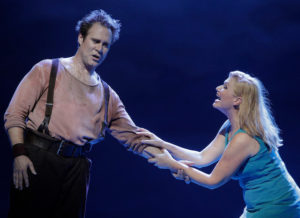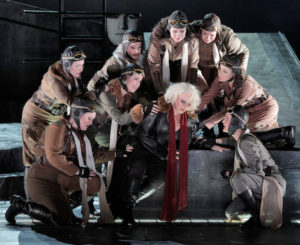The opening music of Wagner’s Ring Cycle begins with a single note played by the lower strings. Low woodwinds join in and then horns, until slowly a chord is formed. Wagner believed this first low note was a primal sound, an aural indication of a first slouching-toward-creation. It’s hard to argue his interpretation, for the sound as it carried out from the orchestra on Tuesday’s opening night seemed saturated with the terror of newness and ominous birth. As quickly as the notes cohered into something melodic – a motif, a sonic gesture – they fractured, and dissolved into air.
A growing tumult of sound was finally broken by the clear voice of the Rheinmaiden Woglinde; her brief solo a kind of vocalese, liquid and wailing, that resolved into language: her exultant salutation to the waters of the Rhein.
In San Francisco Opera’s current remounting of its 2011 “American” Ring, this captivating opening was accompanied by a video projection that filled the front scrim of the stage. Dark images of something like clouds tumbled restlessly, layered and transparent. Something like electricity flashed, binding the vaporous matter into substance, only to disappear like the unformed melodies that rose and fell in the music. The fleeting, layered and fragmentary images were visual analogs of Wagner’s musical leitmotifs.

Throughout the cycle, these visuals, which dominate the musical interludes, refer to the natural world but are more abstract and less solid. Water becomes an ultramarine and white mist, leaves bright patches, stones and rocks layered patterns of shifting terra cottas. All the colors are vivid, as if the sun were shining through a sheer layer of blue or green or gold. The light on stage is enhanced by a new technology that allows imagery to be projected through the floor of the raked stage, so that color radiates from all sides. The lighting by Marc McCullough is also highly saturated and changeable. When the gods leave for Valhalla at the end of Das Rheingold, the stage is flooded with a spectrum of color, a literal remaking of Bifrost, the rainbow bridge connecting Middle Earth and home of the gods.
These new visuals, the original projections by Jan Hartley remounted by S. Katy Tucker, mark the difference between director Francesca Zambello’s earlier version of the cycle and the current production. Through these more abstract visuals the opera makes a stronger push toward the mythic. And in doing so, arguably places the cycle closer to Wagner’s own strivings after the sublime, strivings that both tempered and exacerbated the composer’s desire to merge art with a transcendent form of politics.
Much has been written about Wagner’s proto-fascistic leanings, which were suggested by his virulent anti-semitism, his use of heroic Teutonic mythology, the Nazi party’s adoption of his music as the epitome of Germanic nationalism and his family’s close friendship with Hitler during the war years; though Wagner himself died in 1883, long before the rise of Third Reich. Changing an opera’s setting is almost a cliché in contemporary theater, but Wagner is a composer who needs re-inscribing.
Zambello’s decision to site the Ring in the United States during the last century and a half was inspired; a choice that unloosed the opera from its ties with German nationalism and revealed that the human flaws at the root of the cycle’s conflict are found everywhere in the spectrum of our emotions. That we, as Americans who give much lip service to democracy and the exaltation of opportunity and the common man, are susceptible to greed, lust and the desire for unfettered authoritarian power.
The visual turn toward the mythic, however, makes Das Rheingold less time and site specific. Although the sets and costuming remain the same it’s hard to place the action of opera. It could be middle Europe rather than robber-baron America. It is only in Die Valküre that the cycle becomes unmistakably American. Wotan, the father of the gods, hangs out in a corporate office overlooking a landscape of skyscrapers and urban grandeur. This is clearly New York City, though the surrounding landscape places it in the 1930s. The oddity, of course, is the spear on which Wotan engraves his contracts.

Die Valküre defines the several storylines that will converge into the downfall of the gods and the destruction of the world. In a back-country cabin, the warrior Siegmund appears, wounded and exhausted. There he unwittingly falls in love with Sieglinde; she is his twin sister, both of them the separated and abandoned children of Wotan and a mortal woman. Here also Wagner hits his musical stride, for deep, fevered sensuality is the composer’s forte, underlying even the clang of the hammer and pick in underground mines of the Nibelungen. Under an enormous moon, Karita Mattila and Brandon Jovanovich sing desire into being.
The singers are wonderful throughout Das Rheingold: from the ethereal sopranos of the Rheinmaidens (Stacey Tappan, Lauren McNeese, Renee Tatum) to the dark glowering gold-lust bass of Alberich (sung by Falk Struckmann) and the giants, Fasolt (Andrea Silvestrelli) and Fafner (Raymond Aceto). The gods many colored voices were led by bass baritone Greer Grimsley’s Wotan, and balanced out by the ringing clarity of Stefan Margita’s Loge.

In Die Valküre women’s voices dominated the luscious sound; first, with Mattila’s exquisite purity, then with Jamie Barton’s magisterial Fricka. But it was Iréne Theorin’s warrior maiden that truly gripped the sound waves. Theorin entered the stage like a lightning bolt. Her Brünnhilde was wild and unbridled as she confronted her father Wotan; her battle cry electric as she sang, “Hojotoho! hojotoho! heiaha! heiaha!”
All of it was bound intricately together under the superlative conducting by Donald Runnicles, leading a fine orchestra that was clearly comfortable with the man who stood on the San Francisco Opera House podium for 17 years.
The audience was enraptured.
– Jaime Robles
The San Francisco Opera House presents two additional Ring Cycles beginning on Tuesday June 19 and Tuesday June 26. For information and tickets, visit sfopera.com.
